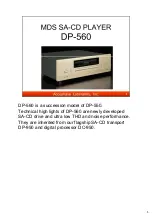
— 2 —
TABLE OF CONTENTS
1. SERVICE NOTES
···························································· 3
2. GENERAL
·········································································· 4
3. DISASSEMBLY
3-1.
Front Cabinet Assy ····························································· 5
3-2.
Control Board ····································································· 6
3-3.
Cabinet (upper) Assy ·························································· 6
3-4.
Power, Battery, Half Battery, Voltage Selection Board ······ 7
3-5.
Volume, Lcd, Mono st, Main Board ··································· 7
3-6.
Mechanism Deck, Optical Pick-up Section ························ 8
4. DIAL POINTER INSTALLATION
······························· 9
5. ADJUSTMENT
5-1.
Mechanical Adjustment ···················································· 10
5-2.
Electrical Adjustment ······················································· 10
5-3.
Tuner Section ···································································· 11
5-4.
Reference ·········································································· 15
6.
DIAGRAMS
6-1.
Circuit Board Location ····················································· 17
6-2.
Block Diagram ································································· 18
6-3.
Printed Wiring Board ························································ 21
6-4.
Schematic Diagram – Main Board(1/3) – ························ 25
6-5.
Schematic Diagram – Main Board(2/3) – ························ 28
6-6.
Schematic Diagram – Main Board(3/3) – ························ 31
6-7.
IC Pin Function Description ············································· 33
7. EXPLODED VIEWS
·················································
38
8. ELECTRICAL PARTS LIST
···································
44
SAFETY-RELATED COMPONENT WARNING!!
COMPONENTS IDENTIFIED BY MARK
!
OR DOTTED LINE WITH
MARK
!
ON THE SCHEMATIC DIAGRAMS AND IN THE PARTS
LIST ARE CRITICAL TO SAFE OPERATION. REPLACE THESE
COMPONENTS WITH SONY PARTS WHOSE PART NUMBERS
APPEAR AS SHOWN IN THIS MANUAL OR IN SUPPLEMENTS
PUBLISHED BY SONY.
Battery life
For CD radio cassette-corder:
FM recording
Sony R20P : approx. 3.5 h
Sony alkaline LR20 : approx. 10 h
Tape playback
Sony R20P : approx. 1.5 h
Sony alkaline LR20 : approx. 5 h
CD playback
Sony R20P : approx. 1 h
Sony alkaline LR20 : approx. 4 h
Dimensions
Approx. 420
×
165
×
256 mm (w/h/d)
(16
5
/
8
×
6
1
/
2
×
10
1
/
8
inches) (incl. projecting
parts)
Mass (incl. batteries)
Approx. 4.2 kg (9 lb. 4 oz)
Supplied accessories
AC power cord (1)
Design and specifications are subject to change without notice.
After correcting the original service problem, perform the
following safety checks before releasing the set to the customer:
Check the antenna terminals, metal trim, “metallized” knobs, screws,
and all other exposed metal parts for AC leakage. Check leakage as
described below.
LEAKAGE
The AC leakage from any exposed metal part to earth ground
and from all exposed metal parts to any exposed metal part having
a return to chassis, must not exceed 0.5 mA (500 microamperes).
Leakage current can be measured by any one of three methods.
1.
A commercial leakage tester, such as the Simpson 229 or RCA
WT-540A. Follow the manufacturers’ instructions to use these
instruments.
2.
A battery-operated AC milliammeter. The Data Precision 245
digital multimeter is suitable for this job.
3.
Measuring the voltage drop across a resistor by means of a
VOM or battery-operated AC voltmeter. The “limit” indication
is 0.75 V, so analog meters must have an accurate low-voltage
scale. The Simpson 250 and Sanwa SH-63Trd are examples of
a passive VOM that is suitable. Nearly all battery operated
digital multimeters that have a 2V AC range are suitable. (See
Fig. A)
SAFETY CHECK-OUT
To Exposed Metal
Parts on Set
0.15
µ
F
1.5 k
Ω
AC
Voltmeter
(0.75 V)
Earth Ground
Fig. A. Using an AC voltmeter to check AC leakage.
Notes on chip component replacement
• Never reuse a disconnected chip component.
• Notice that the minus side of a tantalum capacitor may be
damaged by heat.
Flexible Circuit Board Repairing
• Keep the temperature of soldering iron around 270˚C
during repairing.
• Do not touch the soldering iron on the same conductor of the
circuit board (within 3 times).
• Be careful not to apply force on the conductor when soldering
or unsoldering.



































